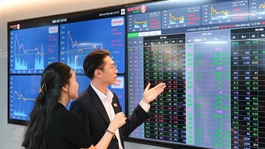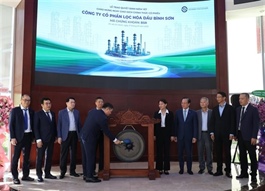Stock market outlook rises amid structural momentum
Stock market outlook rises amid structural momentum
Vietnam’s stock market is showing signs of entering a new growth phase, with experts pointing to rising investor confidence, sector-specific momentum, and renewed foreign capital interest as key drivers.
At a seminar on Vietnam’s stock market outlook through the end of 2025, hosted by Nhat Viet Securities (VFS) on July 17, Can Van Luc, chief economist at BIDV, said GDP growth of 7.52 per cent in the first half of the year signalled a broad-based and substantive recovery.

Stock market outlook rises amid structural momentum |
“This is being underpinned by strategic reforms in areas such as institutional streamlining, governance innovation, and consumption stimulus,” Luc noted. “On this basis, Vietnam’s GDP is forecast to expand by 7.5-7.7 per cent for the full year and may reach 9-10 per cent in 2026, figures that stand out even by regional and global standards. Inflation and exchange rate developments remain broadly under control, contributing to a more stable backdrop for the stock market.”
While the macro indicators are encouraging, Luc cautioned that risks remain. These include both external and domestic headwinds such as geopolitical tensions, sluggish private investment and consumption, uneven public capital disbursement, and vulnerabilities in the bond market. He placed particular emphasis on the risk of retaliatory tariffs from the United States.
According to Luc, such tariffs could weigh on exports and foreign direct investment inflows while increasing competition from third-country imports. To mitigate these challenges, he stressed the importance of proactive diplomatic engagement, enhanced trade cooperation with the US, and targeted support for impacted sectors.
“Balancing trade and addressing outstanding issues through constructive dialogue will be critical,” he said.
Nguyen Minh Hoang, head of Research at VFS, observed that Vietnam’s stock market may be entering a new megatrend, one characterised by improved investor sentiment and rising capital inflows. He noted that the performance of the VN-Index in the first half of 2025 reflected not only technical recovery but also deeper confidence in the country’s long-term reform trajectory.
Hoang drew comparisons with the market’s strong performance in 2021-2022 and projected that the index could climb to the 1,600-point range by year-end, supported by favourable macroeconomic conditions and improving investor sentiment.
“With stronger fundamentals and ongoing reforms, the market’s average price-to-earnings ratio could rise from 13 to 15 times,” he added.
Among the sectors gaining investor attention, real estate is emerging as a clear standout. The industry is currently benefiting from a dual tailwind of capital inflows and supportive policy measures. Despite prior headwinds, real estate stocks remain attractively valued, while signs of market recovery have become increasingly apparent.
Southern regional director of Batdongsan.com.vn Dinh Minh Tuan confirmed that the property sector is entering a new growth cycle. “After a prolonged period of subdued activity due to economic and political uncertainty, property search volumes rebounded strongly in the first half of the year,” he said.
Tuan also highlighted Vietnam’s roadmap for a potential upgrade in stock market classification as a significant long-term catalyst. “To fully harness this momentum, it is critical to accelerate institutional reform, enhance regulatory capacity, and strengthen market transparency, all essential to meeting international standards and attracting stable foreign inflows,” he stressed.
According to Tuan, such an upgrade would not only facilitate stronger foreign capital participation but also offer a more efficient funding channel for the broader economy. “This is particularly vital at a time when private investment and domestic consumption remain subdued,” he added.
He further expressed optimism that ongoing demand from northern provinces into southern markets would continue to support recovery in the real estate sector, thereby providing added impetus to listed property stocks.
Meanwhile, a mid-year investment seminar hosted by Vina Securities a fortnight ago provided additional perspectives on long-term strategies amid evolving macroeconomic conditions.
Vuong Khac Huy, head of Analysis and Investment at Dai-ichi Life Vietnam Fund Management Company, pointed to three core macro trends expected to guide investment decisions: sustained economic growth, a more proactive fiscal policy anchored in public investment, and a gradual rebound in domestic consumption.
“These three drivers are laying the groundwork for stronger corporate earnings and broader economic momentum,” Huy noted. “Provided policies are implemented effectively, they could generate significant spillover effects across key sectors.”
Huy identified several industries well positioned to benefit, particularly those tied to public investment, including construction, infrastructure, and real estate. He also pointed to banking as a beneficiary of stronger credit demand amid improving economic conditions.
Turning to asset allocation, Phung Minh Hoang, senior analyst at Phu Hung Fund Management, advocated for a balanced portfolio approach. “In a low-rate environment, equities and real estate are typically favoured. But for retail investors with limited capital, direct investment in property can be impractical,” he explained.
As a more accessible alternative, Hoang recommended a diversified mix: 50-70 per cent in equities or equity-focused mutual funds, 20-30 per cent in bonds or bond funds for stability, and 10-20 per cent in gold to hedge against macroeconomic and geopolitical risks.
- 08:00 31/07/2025
























